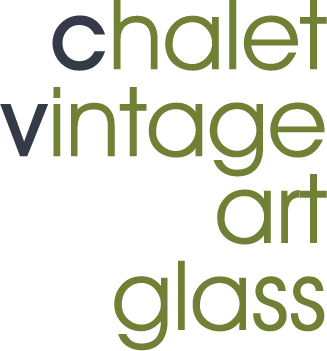Chalet and its “vintage” timeline
Anything you collect - art glass, toys, pottery, jewellery, furniture or lighting, artwork… can be plotted on an historical timeline and then categorized as antique, vintage, retro or modern.
An item’s age is one of the key factors of its value - alongside its condition, quality, and relative rarity. The dating value of an item is evaluated not only in terms of its actual date of production origin but also influenced in the context of contemporary fashions and socioeconomic trends. For example, in lean economic times there may be nostalgia for items from decades associated with comfort and stability. Thereby increasing their monetary value and setting collection trends.
So, what is the correct “ historical classification system” of antique, vintage, retro and modern? And where do pieces by Chalet Artistic Glass and other Canadian glass houses of that time fall?
Correct definitions:
antique: according to Merriam Webster, an antique is: “a relic or object of ancient times” or “a work of art, piece of furniture, or decorative object made at an earlier period and according to various customs laws at least 100 years ago.” Antique glass is glassware produced from the late 1800’s through the mid-1900’s. It comes in a wide variety of colors, styles, and patterns so making collecting it a fascinating hobby. The most collected types are pressed glass, cut glass, blown glass, carnival glass, Vaseline glass, cranberry glass and Depression glass.
vintage: if antiques are things that are 100 years old or older, what are and how old are vintage pieces? The definition of vintage is trickier. According to Merriam Webster, the term vintage relates primarily to wine. However, one of its secondary definitions is, “a period of origin or manufacture” (e.g., a vintage 1960’s Mercedes) or “a length of existence: age.” The “rule of thumb” is that vintage is used in reference to objects at least 25 years old. An item described as vintage usually also speaks to the era in which it was produced. Vintage can mean an item is of a certain period of time, as in “vintage 1950’s” but it can also mean, and probably always should, that the item showcases the best of a certain quality or characteristic associated with or belonging to that specific era. In other words, for the term vintage to most accurately apply to it, an item should be both over 25 years in age and somewhat representational or recognizable as belonging to the era in which it was made. Chalet Artistic Glass operated from 1962-1975 and is iconic Canadian art glass – ground breaking in fact. Therefore, all Chalet pieces may truly be described as vintage. . I am often asked if I can tell when, specifically, a piece of Chalet was produced. In 99% of these requests, I cannot as we have very little resource material that specifically dates Chalet pieces. I can offer only a broad parameters that is also general – in the instances of the Chalet uranium pieces, Canada evoked a 1968 moratorium on the civilian use of uranium om household production so those pieces predate that ban. And we know form the earliest Chalet catalog page that we have, the “Items Available” catalog page, (circa 1962/a163), that pieces shown there are of earlier manufacture.
retro: something, such as a fashion or a trend, from the past or relating to the past or as to the way things were. It is a term describing a style NOT a dating. According to Merriam Webster, the term retro is, “relating to, reviving, or being the styles and especially the fashions of the past : fashionably nostalgic or old-fashioned.” Therefore, art glass that is described as retro may not be actually vintage in age but only designed in a style of the recent past.
modern: methods, ideas, art, design or fashion that is “up-to-date” and is grounded/reflects the current time. Often called “contemporary.”
But not everything you come across, and this is ever true for Chalet Artistic Glass pieces, will have a certified date of origin. Instead, we have to rely on sometimes dubious claims. A quick scan of on-line selling descriptions reveals that terms like antique and vintage are often used interchangeably and sometimes wrongly. The worst are sellers who follow an incorrect “ historical classification system” that goes something like this:
1) Antique: something that is, like, really old. Probably musty, dusty and moldy. Probably made of wood. Usually unstylish.
2) Vintage: something that is too old to be considered “used” but not as old as Grandma. By calling it vintage, the seller tries to distract the buyer from the item’s blatant imperfections. Like many retro items, vintage items are often either mid-century modern , in style if not in date, or related to bygone pop culture, junk food or fashion trends.
3) Retro: something that is basically outdated and out of style. By calling it retro, the seller hopes to assign sentimental or historical value to something that is simply no longer cool. Very often, this is to disguise poor condition or an item that is simply outdated.
You may also see Chalet art glass being described as of the “Eames era” or “mid-century modern.” . So a capsule definition for further clarification.: Charles (1907–1978) and Ray (1912–1988) Eames were American designers, married in 1941, who made major contributions in many fields of design including industrial, furniture and graphic design, art, film, and architecture. Their strongest influence was during the 50’s, 60’s and into the 70’s. The term “Eames era” is often used as a point of reference when dating a piece. As Chalet glass was produced from 1962 until 1975, it can be referenced as being of the Eames era. But as Chalet was produced in Canada and rooted in Murano, I personally feel this is not really its most accurate reference framework.

